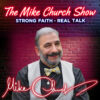chevron_left
-
 play_arrow
play_arrow
The CRUSADE Radio Network CRUSADE Radio Network
-
 play_arrow
play_arrow
PREVIEW: Bongino and Patel Detail Progress Mike "The KingDude" Church
-
 play_arrow
play_arrow
Audio Post Format TheKingDude

